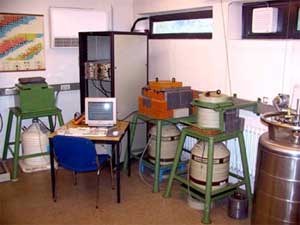Radiation Protection
From 1967 to 1978, about 125,000 containers with low- and about 1,300 drums with intermediate-level waste were emplaced in the former extraction chambers of the Asse mine in rock salt. Since 1.1.1979, disposal of radioactive waste in the Asse mine has been terminated.
The tasks of radiation protection at the Asse mine are therefore mainly based on the Radiation Protection Ordinance and the guidelines derived from it as well as on the regulations and licences of the mining authority. The radiation protection measures serve to protect the personnel against ionising radiation and comprise radiation monitoring of the work performed at the mine as well as monitoring of emissions and environmental radioactivity in the vicinity of the Asse mine.
The main tasks of radiation protection therefore extend to the following activities:
Operational radiation protection
- Performance of person-related measurements
- Determination of personal dose
- Measurements in radiation protection areas
- Local dose measurements
- Dose rate measurements
- Contamination measurements
Gamma spectrometric measuring stations for measuring low-level activities
Emission monitoring of exhaust air
- Determination of the activity concentration in the exhaust air of the mine
- Determination of the meteorological data on the dispersion situation
Immission monitoring
- Measurement of the aerosol activity in the ambient air
- Measurement of the gamma dose and dose rate at selected measuring points in the surrounding area
- Determination of the specific activity of soil, vegetation and water samples
Radiation exposure in the immediate vicinity of the Asse mine
Source: Aerogeophysikalische Erkundungen des Asse Höhenzuges (2001); Federal Institute for Geosciences and Natural Resources (BGR) http://www.bgr.de
The local variations in the natural radiation exposure are due to the different rock and soil types. The radiation exposures measured in the surrounding area of the mine are included in the radiation protection annual reports. The values are within the range of natural radiation exposures at the Asse site.
Meteorological measuring station at the Asse mine
The programmes for exhaust air and environmental monitoring performed by the operator and an independent institution were established according to the Guideline Relating to Emission and Immission Monitoring of Nuclear Facilities. Here, both the amendment of this guideline and the plant- and site-specific conditions of the mine were taken into consideration in agreement with the authority.
All samples for the performance of the operator’s monitoring programme are extracted and collected by personnel of the Asse Research mine.
The measurements and evaluations are performed by the Gesellschaft für Anlagen- und Reaktorsicherheit mbH (GRS) in Braunschweig, the central radionuclide laboratory of the University of Regensburg, the Institute of Radiation Hygiene of the Federal Office for Radiation Protection (BfS) in Neuherberg and the Institute of Radiation Protection of the Helmholtz Zentrum München. The results of the monitoring measurements over many years show that the radiation exposure associated with the disposal of radioactive waste and with the performance of research tasks in the Asse mine make an insignificant contribution, compared to the natural and man-made radiation exposure, both for the personnel and the population in the surrounding area.
In the annual reports on radiation protection and environmental monitoring in the area of the Asse mine, the main data of the operational monitoring and the measurement results obtained from the operator’s environmental monitoring are published:
- Radiation protection annual report 2006; in German [pdf file, 1.0 MB]
- Radiation protection annual report 2005; in German [pdf file, 3.1 MB]
- Radiation protection annual report 2004; in German [pdf file, 1 MB]
- Radiation protection and environmental monitoring; in German [Download of the folder, pdf file, 2.2 MB]
- Radiation protection and environmental monitoring; in German; [Download of the folder, zip file, 1.2 MB]


